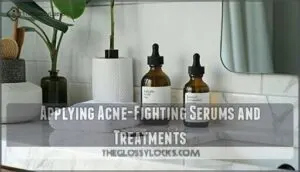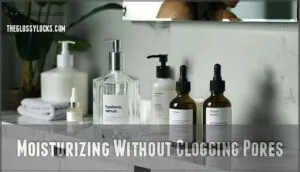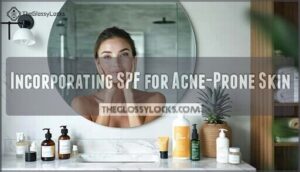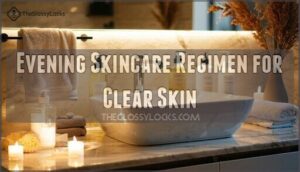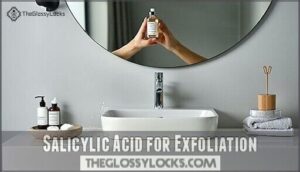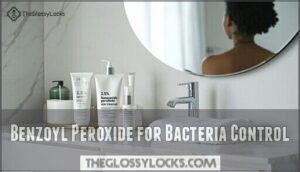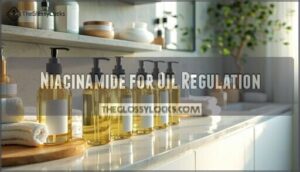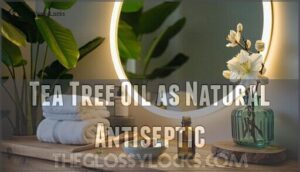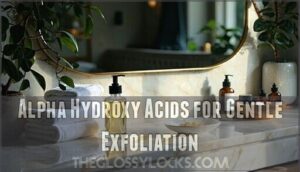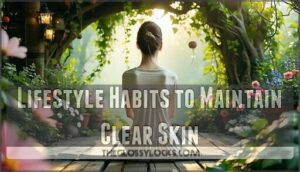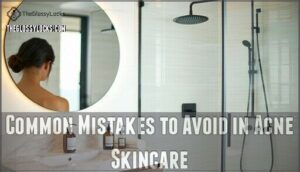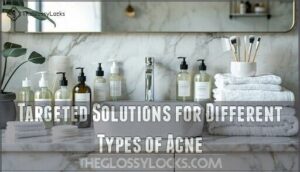This site is supported by our readers. We may earn a commission, at no cost to you, if you purchase through links.
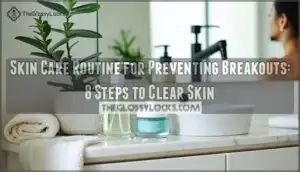 A proper skin care routine for preventing breakouts centers on balance—you’re not waging war on your skin, you’re creating harmony.
A proper skin care routine for preventing breakouts centers on balance—you’re not waging war on your skin, you’re creating harmony.
Start with gentle cleansing twice daily to remove oil and bacteria without stripping your skin’s protective barrier. Follow with a salicylic acid or niacinamide serum to unclog pores and control oil production.
Don’t skip moisturizer, even if you’re oily—dehydrated skin actually produces more oil. Always finish with broad-spectrum SPF in the morning.
The secret isn’t harsh products that leave your face feeling tight, but consistent, gentle care that works with your skin’s natural processes. Sometimes the simplest approaches yield the most dramatic transformations.
Table Of Contents
- Key Takeaways
- Essential Steps for Acne-Prone Skin Care Routine
- Morning Skincare Routine to Prevent Breakouts
- Evening Skincare Regimen for Clear Skin
- Key Ingredients for Preventing Acne Breakouts
- Lifestyle Habits to Maintain Clear Skin
- Common Mistakes to Avoid in Acne Skincare
- Targeted Solutions for Different Types of Acne
- When to Seek Professional Help for Acne
- Frequently Asked Questions (FAQs)
- What is the best skin care routine to prevent acne?
- How do I prevent my skin from breaking out?
- Which skincare routine is best for acne?
- What is a good skincare routine to prevent acne?
- How can I protect my skin from breakouts?
- What should be your daily routine for acne?
- How do you prevent acne breakouts?
- Can I use the same skincare products for body acne?
- How long does it take to see results from a skincare routine?
- Can certain foods trigger acne breakouts and why?
- Conclusion
Key Takeaways
- You’ll need consistency over intensity – cleanse twice daily with gentle, pH-balanced products, apply targeted treatments like salicylic acid, and don’t skip moisturizer even if you’re oily-skinned
- You can’t skip sun protection – use broad-spectrum SPF 30+ daily since many acne treatments make your skin photosensitive, and UV damage worsens inflammation
- You shouldn’t over-cleanse or use harsh scrubs – stripping your skin’s natural oils triggers rebound oil production and micro-tears that worsen breakouts
- You’ll see results in 4-6 weeks – patience matters more than perfection, and lifestyle factors like stress management, proper sleep, and hydration support your skincare routine
Essential Steps for Acne-Prone Skin Care Routine
Building an effective skincare routine for acne-prone skin doesn’t have to feel overwhelming.
The right combination of gentle cleansing, targeted treatments, and consistent protection can help you achieve clearer skin without irritation.
This approach allows for a personalized and effective skincare routine that addresses specific skin concerns.
Gentle Cleansing Techniques
Starting with proper face washing techniques, you’ll want to choose a mild, pH-balanced cleanser that won’t strip your skin’s natural oils.
Here’s your gentle cleansing game plan:
- Select noncomedogenic cleansers – These won’t clog pores while providing effective oil control
- Use lukewarm water – Hot water irritates acne-prone skin and triggers excess sebum production
- Apply gentle circular motions – Let your cleanser do the work, not aggressive scrubbing
- Pat dry with clean towels – Rubbing creates friction that can worsen breakouts and inflammation
Effective skin care routines are essential for maintaining healthy skin and preventing acne.
Exfoliation Methods for Acne-Prone Skin
Regular exfoliation unclogs pores and prevents breakouts, but timing matters.
Chemical peels with glycolic acid work deeper than physical scrubs, making them ideal for acne prevention.
Enzyme exfoliants offer gentler breakout control for sensitive skin.
Microdermabrasion provides professional-grade skin exfoliation. Start with once weekly, then increase frequency as your skin adapts to these exfoliation techniques.
Targeted Spot Treatments
Target those stubborn breakouts with precision using spot treatments that deliver active ingredients exactly where needed.
Spot Treatments work overnight to shrink pimples and reduce inflammation without affecting surrounding healthy skin.
Here are five game-changing blemish control options:
- Salicylic acid spot treatment penetrates pores for effective blackhead removal
- Benzoyl peroxide pimple creams eliminate acne-causing bacteria fast
- Acne patches protect blemishes while drawing out impurities
- Tea tree oil skin soothers calm inflammation naturally
- Sulfur-based whitehead treatment dries out stubborn bumps quickly
Apply these breakout control heroes sparingly – a tiny dab prevents irritation while maximizing acne prevention results.
Noncomedogenic Moisturizers for Oily Skin
After targeted treatments, moisturizing becomes your skin’s safety net.
Oily skin types often skip moisturizer, fearing more breakouts, but that’s backwards thinking. Your skin needs hydration to maintain proper skin pH and prevent overproduction of oil.
Choose noncomedogenic moisturizers designed for oil control that won’t sabotage your acne treatment progress.
When reading product labels, prioritize ingredient safety with these features:
- Hyaluronic acid – attracts moisture without heaviness
- Glycerin – maintains hydration while supporting your skin care routine
- Ceramides – strengthen barrier function against future breakouts
Sun Protection for Acne-Prone Skin
You need broad-spectrum sunscreen with SPF 30 daily—even when it’s cloudy.
UV protection prevents skin cancer and stops acne treatments from making your skin photosensitive.
Choose oil-free sunscreen or noncomedogenic sunscreen that won’t clog pores.
Daily application matters more than perfection, so find a lightweight formula you’ll actually use every morning.
Morning Skincare Routine to Prevent Breakouts
Your morning skincare routine starts the moment you wake up, targeting the oil buildup that occurred overnight while you slept.
Following four essential steps—cleansing, treating, moisturizing, and protecting—sets your skin up for a clear, breakout-free day.
Cleansing Away Overnight Oil Buildup
Your skin works overtime while you sleep, producing oil and accumulating bacteria. Morning cleansing removes this overnight buildup, preparing your skin for the day ahead.
Your skin’s nightly oil production needs morning intervention to start fresh.
Here’s how to master your morning routine with gentle cleansers and effective oil removal tips:
- Start with lukewarm water to soften sebum without shocking your skin
- Choose noncomedogenic, oil-free formulas that won’t clog pores
- Massage gently for 30 seconds to lift impurities without irritation
- Pat dry with a clean towel to prevent bacterial transfer
This simple skin purification step sets the foundation for your daily skincare regimen. Using the right oily skin care techniques can help prevent breakouts and promote clear skin.
Applying Acne-Fighting Serums and Treatments
Precision transforms your morning routine when you apply acne-fighting serums and treatments after cleansing.
Target specific concerns with these powerful ingredients:
| Treatment Type | Best For |
|---|---|
| Salicylic Acid Serum | Blackheads, clogged pores |
| Benzoyl Peroxide | Active breakouts, bacteria |
| Niacinamide | Oil control, inflammation |
Use 2-3 drops of your chosen serum, gently patting into clean skin.
Product layering matters—apply thinnest consistency first for ideal absorption and breakout prevention.
Moisturizing Without Clogging Pores
After your serums work their magic, it’s time to lock in hydration without sabotaging your progress. Choose oil-free formulas with hydrating ingredients like hyaluronic acid and glycerin. These gentle hydrators maintain moisture balance while supporting oil control. Non comedogenic options won’t trigger breakouts, making pore friendly products your skin’s best allies.
- Look for noncomedogenic moisturizers labeled "oil-free" or "won’t clog pores"
- Choose lightweight textures that absorb quickly without leaving residue
- Seek hydrating ingredients like hyaluronic acid, glycerin, and ceramides for moisture balance
- Apply while skin is slightly damp to boost pore minimization and hydration effectiveness
Incorporating SPF for Acne-Prone Skin
Daily sunscreen isn’t just skincare—it’s your skin’s bodyguard against UV damage and inflammation.
Choose non-comedogenic formulas with SPF 30 or higher for maximum acne prevention. Oil-free sunscreens won’t sabotage your morning routine.
| Sunscreen Type | Best For |
|---|---|
| Mineral (Zinc/Titanium) | Sensitive, acne-prone skin |
| Chemical (Avobenzone) | Daily wear, lightweight feel |
| Tinted Formulas | Coverage + protection combo |
| Gel-Based | Oily, acne-prone skin types |
| Powder SPF | Touch-ups over makeup |
Evening Skincare Regimen for Clear Skin
Your evening routine needs to work harder than your morning one, especially after a long day of makeup, pollution, and oil buildup.
Start with double cleansing—micellar water followed by a gentle gel cleanser—to guarantee every trace of the day washes away before you apply your nighttime treatments.
Double Cleansing to Remove Makeup and Impurities
After your morning routine, evening double cleansing becomes your skin’s reset button.
Start with an oil-based cleanser to break down makeup and sunscreen, then follow with micellar water or gentle gel cleanser.
This two-step makeup removal process guarantees complete impurity control without over-scrubbing.
- Facial cleansing with oil dissolves stubborn waterproof products effortlessly
- Skin purification through proper cleansing methods prevents clogged pores overnight
- Complete oil removal allows nighttime treatments to penetrate effectively
Using Retinol for Skin Cell Turnover
After thorough cleansing, you’re ready to harness retinol’s powerful skin renewal capabilities. Think of retinoids as your skin’s personal trainer, pushing cells to work harder and regenerate faster. Start with a pea-sized amount of 0.25% retinol concentration – your skin needs time to adjust to this cell regeneration powerhouse.
Apply retinol after moisturizer to buffer potential irritation while maintaining its anti aging effectiveness. This retinoid therapy approach prevents the dreaded "retinol uglies" that can discourage beginners. Your skin cell turnover will gradually accelerate, unclogging pores and smoothing texture.
Retinol Benefits Tips for Use
Consistency trumps intensity in your acne treatment routine. Within 4-6 weeks, you’ll notice clearer, smoother skin as this cornerstone of effective skin care routine delivers results. For ideal results, consider using a retinol cream product as part of your daily skincare regimen.
Applying Overnight Acne Treatments
Think of overnight acne treatments as your skin’s night shift workers.
Apply spot treatments with benzoyl peroxide or salicylic acid directly to active breakouts.
For widespread concerns, use night serums containing retinoids or sulfur.
Acne patches work wonders on stubborn pimples, while overnight masks promote skin renewal.
These treatments tackle acne while you sleep, maximizing healing time.
Hydrating Night Creams for Acne-Prone Skin
Once your spot treatment or acne treatment is set, reach for a hydrating night cream.
For acne-prone skin, choose oil-free, non-comedogenic formulas packed with hydrating ingredients like hyaluronic acid or ceramides.
These creams help restore moisture balance and support skin renewal overnight, providing benefits such as smoother texture and less irritation—think of it as tucking your skin in for a restful sleep.
Key Ingredients for Preventing Acne Breakouts
Understanding which ingredients work best against acne can transform your skincare routine from guesswork into a targeted approach.
The right active ingredients don’t just treat existing breakouts—they prevent new ones from forming by addressing the root causes of acne formation.
Salicylic Acid for Exfoliation
Salicylic acid works like a gentle janitor for your pores, dissolving oil and dead skin cells that cause breakouts.
This exfoliation powerhouse penetrates deep into follicles, delivering pore unclogging benefits that physical scrubs can’t match.
Start with 0.5-2% concentrations to boost cell turnover without irritation.
Your skin will thank you for this acne treatment upgrade.
For ideal results, continue treatment for at least twelve weeks as beta-hydroxy acid treatments require consistent use to maintain clear skin.
Benzoyl Peroxide for Bacteria Control
Anyone dealing with stubborn breakouts knows benzoyl peroxide is your secret weapon for bacteria control.
This FDA-cleared acne treatment penetrates deep into pores, eliminating acne-causing bacteria that fuel inflammation.
- Start smart: Begin with 2.5% concentration to avoid irritation while achieving effective bacteria control
- Target precisely: Apply thin layers only to affected areas for maximum pore cleansing
- Stay consistent: Results take 4-6 weeks, so maintain your spot treatment routine daily
Niacinamide for Oil Regulation
When oily skin feels like a runaway train, niacinamide steps in to help with oil control and skin balance.
This ingredient regulates sebum, reducing shine and breakouts.
For real niacinamide benefits, use a 5% serum after cleansing and toning. It fits seamlessly into any skin care routine, boosting acne prevention without drying your skin out.
Tea Tree Oil as Natural Antiseptic
While niacinamide tackles excess oil, tea tree oil brings serious antibacterial properties to your skin care routine.
This natural antiseptic offers proven acne treatment benefits without harsh chemicals. Dilute it to 5-10% concentration for safe spot treatment use.
Its natural remedies approach helps with oil control and delivers real skin benefits for acne prevention. Always patch test first.
Using tea tree oil for acne requires careful consideration of its potential to reduce scarring.
Alpha Hydroxy Acids for Gentle Exfoliation
While tea tree oil fights bacteria naturally, alpha hydroxy acids offer a different approach to skin care routine maintenance.
These chemical exfoliants work by dissolving the bonds between dead skin cells, promoting skin renewal without harsh scrubbing.
AHAs like glycolic acid provide gentle exfoliation that prevents breakouts by keeping pores clear.
Here’s how to incorporate AHAs effectively:
- Start with low concentrations (5-8%) to avoid irritation and gradually increase strength
- Choose the right type – glycolic acid for deeper facial resurfacing, lactic acid for sensitive skin
- Use 2-3 times weekly to maintain consistent exfoliation without overdoing it
- Apply at night since AHAs increase sun sensitivity and work best during skin’s repair cycle
Chemical peels containing AHAs deliver exfoliant benefits that reveal smoother, clearer skin underneath.
Remember to always follow with sunscreen the next morning.
Lifestyle Habits to Maintain Clear Skin
Your skincare routine is just one piece of the puzzle regarding preventing breakouts.
The habits you practice outside of your bathroom mirror can be just as important as the products you apply to your face.
Dietary Changes to Reduce Acne
Your diet plays a bigger role in breakouts than you might think.
Research shows reducing dairy intake can lower acne risk by 44%, while low-glycemic index foods decrease lesions substantially.
Sugar impact on inflammation is real – processed foods spike insulin and worsen acne.
Focus on omega balance with fish and walnuts.
Hydration tips: drink plenty of water.
Your skin reflects your nutrition choices.
Stress Management Techniques for Skin Health
Stress creates a perfect storm for breakouts by boosting cortisol levels and triggering inflammation.
Mindful meditation helps reset your nervous system—just 10 minutes daily can make a difference.
Try yoga practices or deep breathing exercises to promote skin relaxation.
Regular stress management through these techniques supports your skin care routine by reducing cortisol-driven oil production.
Stress reduction isn’t just good for your mind; it’s essential for clear, healthy skin health.
Regular Exercise for Improved Circulation
Beyond stress management, Physical Activity becomes your skin’s best friend through improved circulation.
When you establish a consistent Fitness Routine, you’re boosting Blood Flow that delivers nutrients directly to skin cells while flushing out toxins that contribute to breakouts.
Here’s how your exercise routine transforms skin health:
- Cardio Benefits pump fresh oxygen to every pore
- Sweat naturally cleanses impurities from within
- Circulation Boost reduces inflammation that triggers acne
Your workout doesn’t need to be intense—even moderate movement kickstarts these skin-clearing benefits! Understanding the role of skin health fundamentals is essential for creating an effective skincare routine.
Proper Hydration for Skin Detoxification
Your body’s like a washing machine – water intake keeps everything flowing smoothly.
Drink eight glasses daily for ideal skin hydration maintenance, then add detox drinks like green tea to boost your skin flush game.
This simple hydration strategy supports natural skin detoxification while maintaining proper fluid balance for clearer skin.
Adequate Sleep for Skin Regeneration
Quality sleep directly impacts your skin’s ability to fight breakouts and maintain a healthy appearance. Your body’s circadian rhythms control when skin repair happens, making consistent sleep patterns essential for clear skin.
During sleep, your skin enters its regeneration process, producing new cells and repairing daily damage. Poor sleep quality disrupts this natural cycle, leading to increased inflammation and more frequent breakouts.
Here’s how to optimize your sleep for better skin health:
- Maintain consistent sleep and wake times to support your circadian rhythms
- Create a cool, dark sleeping environment to promote deeper regeneration process
- Avoid screens 1-2 hours before bed to prevent disrupting sleep patterns
- Use silk or cotton pillowcases, changing them twice weekly to reduce bacteria
- Aim for 7-8 hours nightly to allow complete skin repair cycles, which is crucial for achieving better skin health and preventing increased inflammation.
By following these steps, you can improve the quality of your sleep and wake up to clearer skin and a more refreshed appearance.
Common Mistakes to Avoid in Acne Skincare
Even the best intentions can backfire in regards to acne care, and many people unknowingly sabotage their progress with well-meaning but harmful habits.
Understanding these common pitfalls can save your skin from unnecessary irritation and help you achieve the clear complexion you’re working toward, which is crucial for effective acne care.
Over-Cleansing and Stripping Natural Oils
When you’re battling breakouts, it’s tempting to scrub away the problem, but overcleansing disrupts your skin’s delicate oil balance.
Harsh products strip natural oils, forcing your skin to overproduce sebum and worsen acne.
Gentle cleansing twice daily maintains natural moisture and skin pH without triggering rebound oiliness.
| Over-Cleansing Signs | Gentle Approach |
|---|---|
| Tight, dry feeling | Soft, balanced skin |
| Increased oil production | Controlled sebum levels |
| Red, irritated patches | Calm, healthy complexion |
| pH imbalance symptoms | Maintained pH balance |
| Compromised skin barrier | Protected oil regulation |
Using Harsh Scrubs and Exfoliants
Scrubbing your face like you’re cleaning grout won’t give you clearer skin. Harsh scrubs and aggressive exfoliation create micro-tears, strip protective oils, and trigger inflammatory responses that worsen breakouts. Your skin interprets this assault as damage, ramping up oil production and causing more acne.
Your skin isn’t your enemy—stop treating it like one.
- Choose chemical over physical: BHAs like salicylic acid penetrate pores without scraping
- Limit frequency: Exfoliate 1-3 times weekly maximum to prevent overexfoliation damage
- Watch for warning signs: Redness, burning, or increased breakouts signal you’re overdoing it
Neglecting to Moisturize Oily Skin
Skipping moisturizer on oily skin backfires.
Your skin overproduces oil to compensate for dehydration, worsening breakouts and clogging pores.
Oily skin care needs hydration too.
Choose lightweight, non-comedogenic moisturizers for proper oil balance and pore minimization.
Moisturizer benefits include strengthened skin barriers and reduced sebum production.
Smart moisturizing routines keep your skin care routine effective.
Touching Face and Picking at Pimples
Your hands harbor bacteria and oils that transfer to your face with every touch.
Face touching and pimple picking worsen breakouts by introducing new bacteria and causing skin irritation.
This habit can lead to scarring and prolonged healing.
Practice hand hygiene and use spot treatment instead of picking.
Keep hands busy with stress balls or fidget toys to break the cycle.
Inconsistent Skincare Routine
Beyond just picking at pimples, your inconsistent skincare routine might be sabotaging your clear skin goals.
Skin neglect through routine inconsistencies creates unpredictable breakout patterns that keep you guessing what’s working.
Your skin thrives on predictability—skipping steps confuses your complexion and triggers more acne.
Product overload from sporadic use causes skin irritation instead of improvement.
Think of skincare routine consistency like taking vitamins; occasional doses won’t deliver results.
- Apply products at the same times daily for maximum effectiveness
- Keep travel-sized versions to maintain your routine anywhere
- Set phone reminders until habits form naturally
- Start with basic steps before adding complex treatments
- Track your routine to identify what triggers breakouts
Consistent acne prevention beats perfect products used randomly.
Establishing a diy skincare routine is essential for achieving clear skin and preventing future breakouts.
This approach ensures that you can maintain a routine that helps in acne prevention and promotes healthy skin habits.
Targeted Solutions for Different Types of Acne
Not all acne is created equal, and your skincare approach shouldn’t be either. Each type of breakout responds best to specific treatments and targeted ingredients that address its root causes.
Treating Blackheads and Whiteheads
Blackheads and whiteheads respond well to gentle pore cleansing with salicylic acid.
Use a spot treatment containing 2% salicylic acid twice weekly for effective blackhead removal and whitehead treatment.
Avoid harsh scrubbing—it’ll backfire and irritate your skin.
Instead, let chemical skin exfoliation do the heavy lifting for consistent acne prevention and clearer pores.
Managing Inflammatory Acne (Papules and Pustules)
Red, swollen papules and pustules need gentle yet effective inflammation control. Apply spot treatment with 2.5% benzoyl peroxide or 2% salicylic acid to reduce redness reduction and kill bacteria.
Don’t squeeze—you’ll worsen inflammation and damage your skin barrier. Inflammatory acne responds well to consistent pustule care on acneprone skin.
Ice cubes wrapped in cloth can calm angry breakouts. Avoid harsh scrubbing that triggers more acne triggers.
Addressing Cystic Acne
For deeper cystic acne cases, you’ll need targeted strategies beyond surface treatments.
These deep, painful bumps require inflammation reduction and careful skin barrier repair.
Essential steps for managing cystic acne:
- Gentle cleansing – Use sulfate-free cleansers to avoid triggering breakout causes
- Professional spot treatment – Apply benzoyl peroxide carefully to reduce bacteria
- Prescription retinoids – Help prevent future cyst formation through cell turnover
- Anti-inflammatory ingredients – Niacinamide calms irritated skin effectively
- Dermatologist consultation – Essential for preventing permanent acne scars
Remember, cystic acne often stems from hormonal fluctuations and requires patience with consistent care.
Combating Hormonal Acne
Hormonal acne disrupts your natural hormone balance, creating stubborn breakout patterns.
Track your cycle to identify acne triggers and adjust your routine accordingly.
Acne-fighting ingredients like salicylic acid and benzoyl peroxide help with oil regulation and skin purification.
Consider hormonal treatments with your doctor.
| Trigger | Solution | Timeline |
|---|---|---|
| Menstrual cycle | Track patterns, adjust routine | 2-3 cycles |
| Birth control changes | Consult doctor, be patient | 3-6 months |
| Stress hormones | Manage stress, sleep well | 4-8 weeks |
| Diet factors | Reduce dairy, sugar | 6-12 weeks |
| PCOS/thyroid | Medical evaluation needed | Varies |
Preventing and Treating Acne Scars
Acne scars don’t have to be permanent reminders of past breakouts. With proper scar prevention and targeted treatments, you can achieve smoother skin texture and reduce hyperpigmentation effectively.
Professional skin resurfacing treatments offer the most dramatic results for established acne marks. Laser therapy and chemical peels stimulate collagen boosting while breaking down scar tissue. At-home options include retinoids and vitamin C serums for gradual improvement.
Prevention remains your best strategy during active breakouts:
- Avoid picking or squeezing pimples – this damages surrounding tissue and increases scarring risk
- Use gentle spot treatments with salicylic acid instead of harsh scrubbing
- Apply sunscreen daily to prevent darkening of existing marks
- Start acne-fighting ingredients early to minimize inflammation and tissue damage
Consistent scar minimization requires patience, but combining professional treatments with proper breakout prevention creates the clearest path forward.
When to Seek Professional Help for Acne
Sometimes your at-home skincare routine isn’t enough, and that’s completely normal—even the most dedicated routine can’t tackle every acne situation.
If you’re dealing with deep, painful cysts, widespread breakouts that won’t respond to over-the-counter treatments, or acne that’s leaving permanent scars, it’s time to call in the professionals.
Signs of Severe or Persistent Acne
When breakouts become your skin’s permanent roommate, it’s time for professional backup.
Severe breakouts feature painful nodules, cysts, or persistent acne scarring across your face, chest, or back.
Persistent breakouts resist over-the-counter treatments for months, creating ongoing skin inflammation and breakout patterns.
These acne symptoms signal deeper issues requiring dermatologist intervention.
Benefits of Dermatologist-Prescribed Treatments
Struggling with stubborn breakouts? Dermatologist guidance transforms your skincare routine through personalized skin analysis and targeted treatment plans.
Prescription medications like topical retinoids or oral antibiotics tackle severe acne more effectively than over-the-counter options.
Your dermatologist creates customized protocols based on your skin’s specific needs, ensuring faster, safer results than trial-and-error approaches.
Professional Acne-Fighting Procedures
When over-the-counter acne treatments aren’t cutting it, dermatologists offer powerful professional treatments that pack a serious punch.
Laser therapy targets deep inflammation, while chemical peels resurface damaged skin layers.
Microdermabrasion buffs away stubborn blackheads, and blue light therapy zaps acne-causing bacteria.
Some cases need acne surgery for extraction.
These procedures complement oral antibiotics and topical retinoids for thorough care.
Combination Therapies for Stubborn Acne
When standard treatments hit a wall, your dermatologist might prescribe combination therapies for stubborn acne.
These multi-pronged approaches tackle different causes simultaneously:
- Topical retinoids + oral antibiotics for acne prevention and bacterial control
- Benzoyl peroxide + hormonal treatments targeting inflammation and hormone-driven breakouts
- Professional spot treatment + at-home acne-fighting ingredients for thorough dermatological care
This strategic skin regeneration approach delivers clearer results than single treatments alone.
Frequently Asked Questions (FAQs)
What is the best skin care routine to prevent acne?
Cleanse twice daily with gentle, pH-balanced cleanser. Apply salicylic acid serum to unclog pores. Use lightweight, non-comedogenic moisturizer. Apply broad-spectrum SPF 30+ sunscreen daily. You’ll see clearer skin with consistent routine.
How do I prevent my skin from breaking out?
Sure, let’s pretend bacteria just love hosting pool parties in your pores.
Establish consistent cleansing with salicylic acid, moisturize daily, use non-comedogenic products.
Apply broad-spectrum sunscreen, and maintain clean towels and pillowcases regularly.
Which skincare routine is best for acne?
Start by cleansing twice daily with a gentle, pH-balanced cleanser.
Apply salicylic acid or benzoyl peroxide treatments to target breakouts.
Follow with lightweight, non-comedogenic moisturizer and broad-spectrum SPF 30+ sunscreen daily for best results.
What is a good skincare routine to prevent acne?
Breaking out feels like your skin’s staging a rebellion, but you’ve got the power to restore peace.
Cleanse twice daily with salicylic acid, apply lightweight moisturizer, and use broad-spectrum SPF daily for clear skin.
How can I protect my skin from breakouts?
Keep your face clean with gentle, twice-daily cleansing and avoid touching it throughout the day.
Use non-comedogenic products, maintain consistent routines, manage stress levels.
Always apply broad-spectrum sunscreen for protection.
What should be your daily routine for acne?
Cleanse twice daily with a gentle cleanser, apply salicylic acid or benzoyl peroxide treatment, moisturize with non-comedogenic products, and use broad-spectrum SPF 30+ sunscreen daily for clear skin.
How do you prevent acne breakouts?
Establish a consistent daily routine with gentle cleansing, targeted treatments using salicylic acid or benzoyl peroxide, lightweight moisturizing, and broad-spectrum sunscreen. You’ll also want to manage stress effectively.
Can I use the same skincare products for body acne?
Like medieval physicians prescribing leeches, you shouldn’t use face products on your body.
Body acne needs stronger concentrations and different formulations.
Face products won’t penetrate thick body skin effectively, leaving you frustrated.
How long does it take to see results from a skincare routine?
You’ll typically notice improvements in 4-6 weeks with consistent use. Some people see initial changes within 2-3 weeks, while stubborn breakouts may take 8-12 weeks to respond completely.
Can certain foods trigger acne breakouts and why?
Like knights of old battling skin demons, you’ll find that high-glycemic foods and dairy can trigger breakouts by spiking insulin levels, which increases oil production and inflammation in your pores.
Conclusion
Studies show that 85% of people aged 12-24 experience some form of acne, making effective prevention essential.
Your skin care routine for preventing breakouts doesn’t need to be complicated—consistency matters more than complexity.
Start with gentle cleansing, incorporate proven ingredients like salicylic acid or niacinamide, and don’t skip moisturizer even on oily skin.
Remember, clear skin is a marathon, not a sprint, with patience and the right approach, you’ll develop healthy habits that keep breakouts at bay for years to come.


